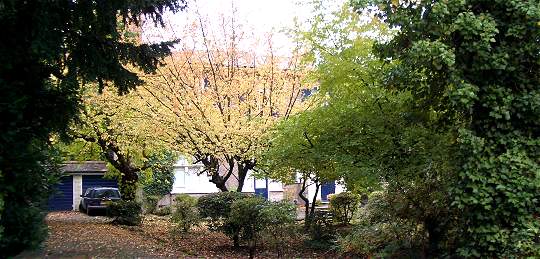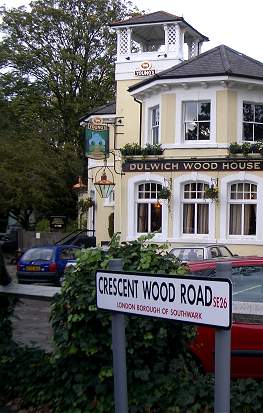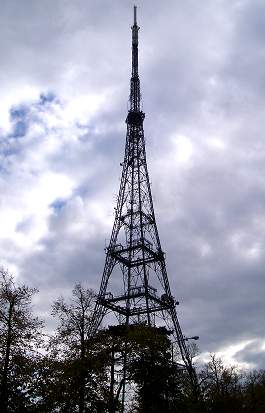|
3 Crescent Wood Road, Sydenham
The home of colour
television, high definition television and
John Logie Baird
1933-1946
No 3 Crescent Wood Road today hidden behind bushes
& trees
 |
|

Dulwich Wood House
No
3 is to the left just beyond the tree
|

Today's Crystal Palace
TV transmitter
only ½ mile away along Sydenham Hill
|
John Logie Baird invented Television in 1926. He also
patented a system which later became known as Radar. He helped the BBC begin
the first public television service in 1932.
He moved to Crescent Wood Road on Sydenham Hill and
established the world's first major TV Studio and Broadscasting Complex at the
Crystal Palace - less than a mile away.
His initial TV system was electro-mechanical and during
the thirties Baird Television came under intense competition from a complete
electronic system pioneered by Marconi-EMI. There was a dramatic 'play-off'
conducted by the BBC & UK Government in 1936 for the first high definition
(for the time) TV system. Marconi-EMI won and Baird Television was finished as
a successful commercial enterprise.
But John Logie Baird did not give up. Instead he
embraced electronic TV and with the aid of just two assistants continued work
in his Crescent Wood Road laboratory. Here Baird developed of the worlds first
colour television system - first at 600 lines which he successfully
demonstrated in December 1940 at Crescent Wood Road. He later went on to test a
very high definition version of 1800 lines - three times the definition of
current colour TV and even higher than currently proposed High Definition TV
systems. He also did pioneering work in 3D stereoscopic TV.
Baird testified to the Hankey Committee in 1943 on how
post war television should develop. He argued for 1000+ line systems. This was
not to be. The UK system upto 1964 was based solely on EMI's 405 line system
and even now is still only 625 lines. It may be a few more years before we see
1000 line colour television again in Sydenham homes.
The onset of war in 1939 meant that much of his work
was believed to have been diverted in to the development of radar and other
electronic systems to aid the war effort. This secret work is still classified
so we will have to wait a little longer to hear the full story of John Logie
Baird's great work in Sydenham.
Baird has, however, left a legacy that we all still
enjoy in our homes today. The Sony Trintron tube follows from his work on using
a single gun colour cathode ray tube. A significant amount of pre-recorded TV
uses the film scanning system of Rank-Cintel (who had takern over Baird's
Cinema Television) and the everyday video casstte recorder was the ultimate
exploitation of electro-mechanical scanning in the reproduction of
TV.
Baird's work has rarely been fully recognised. The US
actually declared their Philo Farnsworth to have invented TV in 1927 a later
and an inferior system! Perhaps Sydenham should reconsider how it should
recognise a pioneer who invented the most significant way people today access
information and entertainment.
Meanwhile here are a set of articles whose authors have
graciously permitted us to republish in Sydenham Town:
We would be delighted to receive any other interesting
articles or memories of John Logie Baird's work in Sydenham and Crystal
Palace.
|